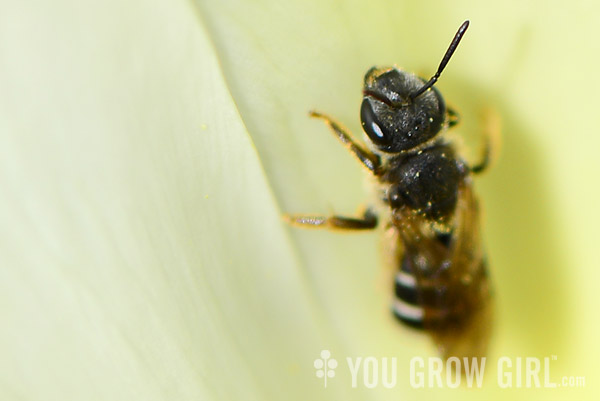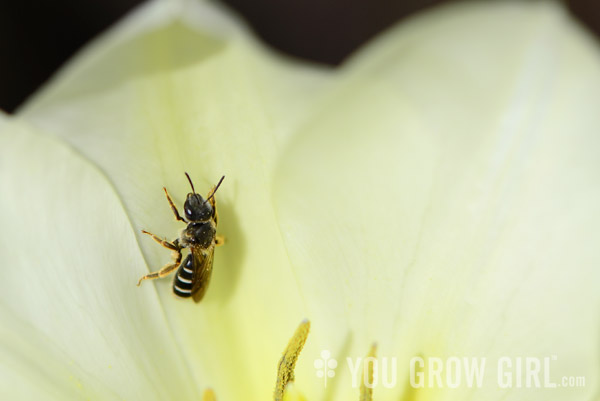
I have not been very diligent about posting here, but I have continued to follow the directive I set for myself in 2016 to photograph and identify the bees and other insects that inhabit my garden.
Aliens in My Garden is a series capturing the fascinating insects that inhabit my small, urban garden. While many of these tiny creatures are native, the title is a reference to their otherworldliness.
I think part of my hesitancy in posting is recognizing that I am a total novice. This is an area of much new learning for me, and I feel shy about asserting any identifications that I make. Just between bees and wasps alone the range of diversity in my small urban garden is exciting, but daunting. I am slowly learning, so please know that while I take care in trying to consult numerous sources in the hopes that I am getting it right, the insect identifications I make here are a bit wobbly. I am no authority.

I captured this tiny Ligated Sweat Bee (Halictus ligatus) resting inside the soft cup of a creamy tulip last April. The little critters are a common sight in the garden. I think this is because they are generalists that pollinate all sorts of flowers, and there’s always something blooming in my garden from the earliest days of the season until the last. They like to nest in the ground and I have loose, sandy soil, especially the area in the middle of the garden that I don’t amend that I refer to as the Dry Bed.
Resources
I have a range of insect information and identification books in my personal library, but when it comes to bees, I tend to reach for the following:
- The Bees in Your Backyard: A Guide to North America’s Bees by Joseph S. Wilson
- Bees, Wasps, and Ants: The Indispensable Role of Hymenoptera in Gardens by Eric Grissel
- Bees of Toronto freely available through the City of Toronto Biodiversity Series
Links to books in this post are associated with an affiliate account that garners a small fee that I then put towards purchasing books to review and giveaway.
I started adoring bees some time ago, but have not yet managed to really get into serious identification. Maybe some of the books you mention might be helpful, but I guess I should rather look for some specialized on bees in northern Germany…
I am always in awe when you post pictures of those amazing, delicate beings :) No matter how new you yourself are to this topic. So thanks for overcoming that hesitation time and time again.
Thanks for capturing these incredible creatures and to turning us on to the world of bees beyond the European honeybee.
This is a good post on bees. Where I live we have bees surrounding our small retail garden shop almost year round. They never seem to bother me or our customers. The Ligated Sweat Bee you mentioned here is smaller than the ones we have. I am curious as to what type they are? The resources you mentioned are a big help. We are from the Southwest region of the U.S. BTW…Great garden blog website.
So interesting! We had several different types of bees visiting us last year, but I think we might normally have more since it was such a smoky year from the wildfires. I didn’t like being outside in it, and I’m sure they felt it even more strongly. Thanks for posting!
Awesome article once again. I am binge-reading your posts :)